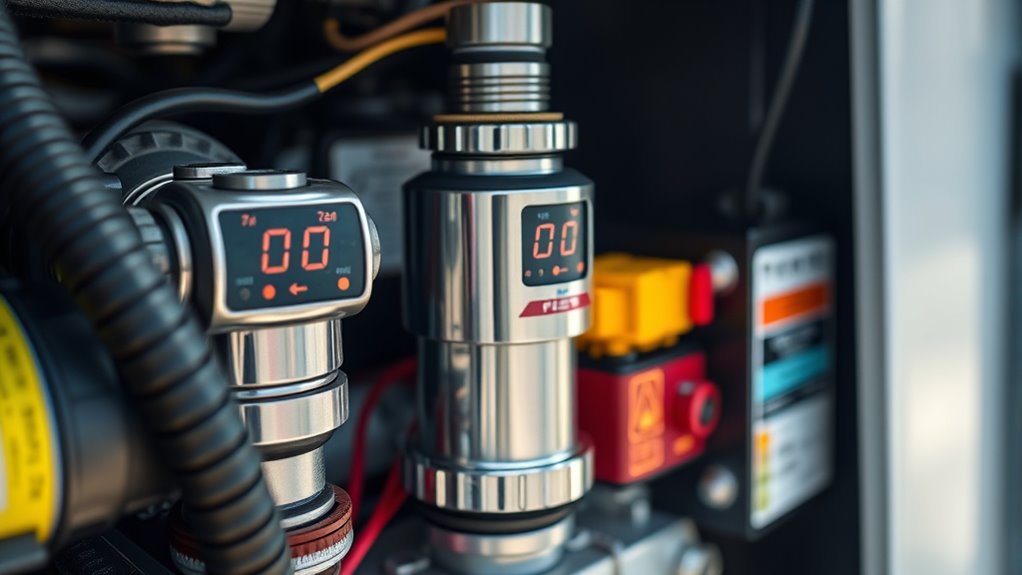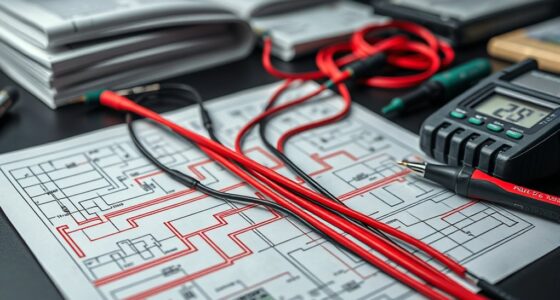To keep your generator’s CO safety sensors reliable, regularly test and calibrate them following the manufacturer’s instructions. Watch for signs of malfunction, like false alarms or inconsistent readings, and clean sensors gently to prevent damage. Make certain proper ventilation and handle replacements carefully, turning off power beforehand. If issues persist or you’re unsure, call a professional to ensure your safety. Staying on top of maintenance will help you protect your environment and loved ones, so explore more to learn how.
Key Takeaways
- Regularly test and calibrate CO sensors to ensure accurate detection and prevent false alarms.
- Recognize signs of faulty sensors, such as inconsistent readings or delayed alarms, and address them promptly.
- Follow manufacturer instructions for proper installation, calibration, and maintenance to ensure sensor reliability.
- Maintain proper ventilation and keep vents clear to enhance sensor performance and prevent CO buildup.
- Seek professional help when persistent sensor issues, false alarms, or generator performance problems occur.
Understanding How CO Safety Sensors Work

To understand how CO safety sensors work, it’s vital to know that they are designed to detect dangerous levels of carbon monoxide gas in the environment. Proper sensor calibration ensures the device accurately measures CO concentrations, preventing false alarms or missed detections. Regular calibration aligns the sensor’s readings with known CO levels, maintaining reliability. Additionally, sensor compatibility is essential; choose sensors compatible with your generator’s specific model and power requirements. Compatibility affects how well the sensor integrates with the system and influences its responsiveness. When you install or maintain these sensors, verifying calibration and ensuring compatibility helps guarantee they function correctly, providing reliable protection. Understanding these factors allows you to keep your generator safe and compliant with safety standards. Sensor performance metrics play a crucial role in ensuring accurate detection and timely alerts.
Why Regular Testing Is Essential

Regular testing of your CO safety sensors helps catch malfunctions early, preventing dangerous situations. It also verifies that the sensors remain dependable over time. By staying on top of testing, you ensure your generator’s safety systems work when you need them most. Incorporating preventive maintenance practices can further enhance the reliability of your safety devices.
Detects Malfunction Risks
Since safety sensors are critical for detecting potential malfunctions, neglecting regular testing can leave your generator vulnerable to unnoticed issues. Regular testing ensures the sensors stay properly calibrated, which is essential for accurate detection of carbon monoxide leaks. If sensors aren’t calibrated correctly, they might fail to alert you to dangerous conditions, risking both safety and equipment damage. Following safety protocols during testing helps verify that sensors respond appropriately under real-world scenarios. This proactive approach catches malfunctions early, preventing more severe problems down the line. By consistently testing and calibrating your sensors, you maintain their ability to detect risks reliably. Incorporating proper maintenance into your routine further supports sensor performance and longevity. Skipping these steps increases the chance of undetected malfunctions, compromising safety and potentially leading to costly repairs or accidents.
Ensures Sensor Reliability
Performing regular testing is critical to maintain the reliability of your generator’s safety sensors. Consistent checks ensure that sensors are properly calibrated and correctly placed, preventing false alarms or missed detections. Regular testing helps identify issues early, so you can address them before a critical failure occurs. Proper sensor calibration guarantees accurate readings, while correct sensor placement ensures maximum coverage. Keep these points in mind:
- Schedule routine sensor calibration sessions
- Verify sensor placement matches manufacturer guidelines
- Test sensors in different environmental conditions
- Replace faulty sensors promptly
- Document testing results for future reference
Ensuring sensor effectiveness through regular assessments is essential for optimal generator operation and safety.
Step-by-Step Guide to Sensor Maintenance

Maintaining the CO safety sensors on your generator is vital to guarantee reliable operation and safety. Start by inspecting the sensor for dirt, dust, or corrosion, and clean it gently with a soft cloth if needed. Next, check sensor compatibility to confirm it matches your generator model and specifications. Regular sensor calibration is essential; follow the manufacturer’s instructions to adjust sensitivity levels correctly, guaranteeing accurate CO detection. When calibrating, use the proper testing equipment and verify the sensor responds appropriately to test gases. Replace the sensor if it shows signs of damage or if calibration fails repeatedly. Always refer to your generator’s manual for specific maintenance procedures, and perform these steps at regular intervals to keep your CO safety sensor functioning at its best. Additionally, understanding the importance of contrast ratio can help in selecting the right viewing setup to ensure clear visual indicators during maintenance checks.
Recognizing Signs of a Faulty Sensor

A CO safety sensor that’s malfunctioning can give false readings or stop responding altogether, posing serious safety risks. You should watch for signs like inconsistent readings, delayed alarm response, or no response when CO levels rise. Poor sensor calibration may cause it to miss actual danger levels, so accurate calibration is essential. Also, listen for false alarms or a failure to trigger the alarm when CO is present. Other signs include frequent sensor errors or erratic behavior. Regularly testing your sensor helps ensure proper alarm response and calibration. Recognizing these signs early prevents dangerous CO buildup. Keep an eye on:
- Inconsistent readings
- Delayed or absent alarm response
- False alarms
- Sensor error messages
- Erratic sensor behavior
Proper calibration is vital for maintaining reliable sensor performance and ensuring safety.
Replacing Your CO Safety Sensor

Replacing your CO safety sensor involves carefully removing the old unit and installing a new one. You’ll need to follow specific steps to guarantee proper fit and connection. Once done, testing the sensor confirms your generator’s safety and functionality. Incorporating advanced sensors, such as AI-powered detection, can further enhance safety measures in generator maintenance.
Sensor Removal Process
Are you ready to remove and replace your CO safety sensor on your generator? First, turn off the generator and disconnect the power source. Locate the sensor, usually near the exhaust or engine compartment. Carefully disconnect the wiring harness, ensuring you don’t damage the connectors. Remove the mounting screws or clips holding the sensor in place. Keep in mind, handling the sensor gently preserves its calibration. Before installing the new sensor, perform sensor calibration checks to ensure accuracy. Also, conduct battery checks on your generator to prevent electrical issues. Remember:
- Use proper tools to avoid damaging components
- Handle the sensor with care and avoid contamination
- Document the removal process for future reference
- Avoid forcing the sensor out, which could cause damage
- Double-check wiring connections after removal
- Enhanced sensor calibration techniques can help improve your generator’s safety performance.
Installing a New Sensor
With the old sensor removed and the mounting area prepared, it’s time to install the new CO safety sensor. First, verify the sensor is compatible with your generator model to prevent calibration issues. Carefully insert the sensor into the designated mount, aligning connectors properly. Once in place, tighten the fittings without overtightening, which could damage the sensor. After installation, perform sensor calibration to ensure accurate readings. Use the manufacturer’s calibration procedure to fine-tune the sensor’s response. Here’s what you might visualize:
| Sensor Placement | Calibration Process |
|---|---|
| Correct alignment | Follow steps in manual |
| Secure fittings | Adjust sensitivity settings |
| Compatibility check | Test the sensor’s accuracy |
| Proper sealing | Confirm readings after calibration |
Additionally, ensure you follow proper maintenance protocols to keep the sensor functioning effectively over time.
Common Mistakes to Avoid During Maintenance

To guarantee your generator’s safety sensors function correctly, it’s crucial to avoid common maintenance mistakes. First, neglecting proper sensor calibration can cause inaccurate readings. Second, skipping voltage testing may result in undetected wiring issues. Third, handling sensors roughly can damage sensitive components. Fourth, ignoring manufacturer instructions risks improper installation or adjustment. Fifth, failing to check for corrosion or dirt can interfere with sensor performance. Always ensure you calibrate sensors correctly and perform voltage testing regularly. Clean sensors gently and follow manufacturer guidelines for installation. Avoid rushing through maintenance tasks, as precision is key to reliable operation. Additionally, referring to vetted HARTSBURG NEWS resources can provide valuable guidance on proper sensor maintenance. By paying close attention to calibration and testing procedures, you’ll keep your CO safety sensors functioning optimally and maintain your generator’s safety.
Ensuring Proper Ventilation for Safety

Proper ventilation plays a key role in maintaining generator safety and ensuring the effectiveness of your CO safety sensors. A well-designed ventilation system helps prevent the buildup of dangerous carbon monoxide by promoting proper airflow. To optimize airflow, ensure vents are clear of obstructions and positioned to direct fumes away from inhabited areas. Regularly inspect your ventilation system for damage or blockages, especially after storms or heavy use. Proper airflow not only protects your health but also allows your sensors to operate accurately, detecting CO leaks early. Remember, inadequate ventilation can lead to dangerous concentrations of CO, making safety sensors less effective. Prioritize airflow optimization as part of your maintenance routine to keep your generator environment safe and your sensors functioning reliably.
When to Call a Professional

Knowing when to call a professional is essential to guarantee your generator’s safety and proper functioning. If you notice persistent issues with CO safety sensors, declining fuel efficiency, or increased noise that you can’t resolve, it’s time to seek expert help. A professional can accurately diagnose problems and ensure your generator operates safely. Don’t delay if you observe:
- Sensor malfunctions or false alarms
- Persistent CO leaks despite troubleshooting
- Significant drops in fuel efficiency
- Excessive noise during operation
- Difficulty resetting safety sensors
Calling an expert prevents potential hazards, ensures proper noise reduction, and maintains ideal fuel use. Regular inspections and timely professional intervention keep your generator running smoothly and safely, especially when dealing with CO safety sensors.
Frequently Asked Questions
How Long Do CO Safety Sensors Typically Last?
Co safety sensors typically last around 5 to 7 years, but this can vary based on usage and environmental conditions. You should check the sensor’s lifespan regularly and plan for replacement when it approaches the end of its expected lifespan. To guarantee safety, it’s important to follow the recommended replacement frequency and test the sensor periodically, especially if you notice any warning signals or decreased sensitivity.
Are There Different Types of CO Sensors for Generators?
Yes, there are different types of CO sensors for generators, including electrochemical, metal oxide semiconductor, and infrared sensors. When selecting a sensor, you should consider sensor calibration and installation best practices to guarantee accurate detection. Proper calibration maintains sensor reliability, while correct installation ensures safety and compliance. Understanding these variations helps you choose the right sensor for your generator, enhancing safety and performance.
Can DIY Maintenance Void My Generator’s Warranty?
Yes, DIY maintenance can void your generator’s warranty. If you don’t follow proper procedures, you risk damaging components like the CO sensor, affecting its calibration and battery lifespan. Improper handling may also lead to inaccurate CO detection, compromising safety. Always read your warranty terms and consider professional service to guarantee your generator remains protected and fully functional, preserving your warranty coverage.
What Are the COsts Associated With Replacing a CO Sensor?
Replacing a CO sensor can cost you between $50 and $150, depending on your generator model and sensor quality. Like a ticking time bomb, sensors have a lifespan of about 5-7 years, so plan for replacements as they age. The cost covers parts and labor, with higher-end sensors lasting longer but costing more upfront. Regular maintenance guarantees your safety system remains dependable and avoids unexpected expenses.
How Can I Improve Overall CO Safety on My Property?
You can improve overall CO safety on your property by ensuring proper indoor air quality and installing reliable CO detectors in key areas. Regularly maintain and test your sensors, especially near generators and appliances that produce combustion gases. Practice fire prevention by keeping vents clear and avoiding indoor use of portable heaters. Educate your family about CO risks, and create an emergency plan to respond quickly if a sensor detects dangerous levels.
Conclusion
Regularly maintaining your CO safety sensors isn’t just about compliance — it could be the difference between safety and disaster. Some experts believe that sensors might become less effective over time, almost like how our senses dull without proper care. Keep testing, replacing, and ensuring proper ventilation. By staying vigilant, you’re not just protecting your generator, but safeguarding everyone around you. Remember, a well-maintained sensor is your best defense against unseen dangers.









